I remember that not everyone knows what the world looks like from 500 feet up.
The other day, while I was down in Surprise, AZ, doing a bit of “analog shopping” — that’s the kind of shopping where you physically walk into a store and look around and maybe buy something but maybe don’t, as opposed on online shopping, which is how I usually buy things other than food or fuel — I suddenly realized that most people don’t have any idea what the area around their homes, schools, or businesses looks like from the air. Right now, I can’t remember what triggered that thought, but I do recall that it hit me hard — hard enough to remember, anyway. I told myself to give the idea some thought and blog about it.
Chances are that you are one of the people who haven’t seen your local environment from the air and you probably don’t think that’s a big deal. Most people haven’t. And that’s what hit me so hard: that the pilots of small aircraft are a minority, not just because they fly, but because they’ve seen so many things from above.
The View from My Seat
I started flying in 1998 or 1999 (need to check my log book to be sure). Back then, I spent most of my flight time just thinking about flying. I was taking lessons to learn how to fly and didn’t have much time to admire the view. But the time I could fly, the view had become second nature.
 So yes — I know what a subdivision looks like from the air. And a school with ball fields. And a park and a town pool. I’ve seen all kinds of backyards, from perfectly trimmed, walled-in plots of grass or decorative rock to sprawling, weed- and junk-filled patches of desert. I’ve seen small downtowns, both dead and alive. I’ve seen where the pavement turns to dirt and what lies five miles beyond. Or ten. Or fifty.
So yes — I know what a subdivision looks like from the air. And a school with ball fields. And a park and a town pool. I’ve seen all kinds of backyards, from perfectly trimmed, walled-in plots of grass or decorative rock to sprawling, weed- and junk-filled patches of desert. I’ve seen small downtowns, both dead and alive. I’ve seen where the pavement turns to dirt and what lies five miles beyond. Or ten. Or fifty.
 I’ve seen desert lakes and rivers winding through canyons. I’ve seen dams along the Colorado and canals stretching as far as the eye can see. I’ve seen, from the air, natural wonders, like the Grand Canyon, Meteor Crater, the Little Colorado River Gorge, the Grand Falls of the Little Colorado River, and Rainbow Bridge. I’ve flown beside red rocks in Sedona and Monument Valley buttes. I’ve peeked into open pit mines from above and have felt as small as a speck flying down the emptiness of Death Valley. Recently, I’ve flown over Alaskan glaciers blanketed with fresh, pristine snow that went on for twenty, thirty, or forty miles without so much as a footprint to disturb it.
I’ve seen desert lakes and rivers winding through canyons. I’ve seen dams along the Colorado and canals stretching as far as the eye can see. I’ve seen, from the air, natural wonders, like the Grand Canyon, Meteor Crater, the Little Colorado River Gorge, the Grand Falls of the Little Colorado River, and Rainbow Bridge. I’ve flown beside red rocks in Sedona and Monument Valley buttes. I’ve peeked into open pit mines from above and have felt as small as a speck flying down the emptiness of Death Valley. Recently, I’ve flown over Alaskan glaciers blanketed with fresh, pristine snow that went on for twenty, thirty, or forty miles without so much as a footprint to disturb it.
I’ve seen so many things from the air — often from 500 to 1000 feet up — that when I’m on the ground, I can often envision what the place might look like from the air.
 That doesn’t mean I’m bored with the view. While I’ll admit that spending 20 minutes to cross an empty valley in some of the more remote areas of Nevada and California can get pretty dull, there’s always something interesting to notice along the way. Perhaps it’s a deserted homestead, half blown away by wind or covered by sand. Or some ATVs speeding along a transmission line road, sending up a cloud of dust that reveals their position. Or maybe it’s just an odd rock formation, jutting out of the otherwise flat terrain like the ruins of a half-sunken ship.
That doesn’t mean I’m bored with the view. While I’ll admit that spending 20 minutes to cross an empty valley in some of the more remote areas of Nevada and California can get pretty dull, there’s always something interesting to notice along the way. Perhaps it’s a deserted homestead, half blown away by wind or covered by sand. Or some ATVs speeding along a transmission line road, sending up a cloud of dust that reveals their position. Or maybe it’s just an odd rock formation, jutting out of the otherwise flat terrain like the ruins of a half-sunken ship.
I wish I could share these images with others, but it’s tough. When I fly, my right hand is always on the cyclic. Cameras are designed to be used with the right hand. Although I’ve become pretty good at taking photos with my left hand, only a small percentage of those shots really show what I’m seeing, without glare and reflections from the cockpit bubble. And sometimes the interesting things I fly by go by very quickly — too quickly to snap a photo. Like the Indian cliff dwelling I passed on a flight from Howard Mesa to Scottsdale at least a year ago; I was in too much of a hurry to circle back and see it again — or get the GPS coordinates. I haven’t found it again.
I write about many of my flights in this blog. If I have photos, I share them. If you’re new to this blog and want to read a few of my better efforts, be sure to check out these:
- Page to Havasu by Helicopter
- Breakfast in Winslow…No, Page…No, Marble Canyon
- The Winslow Loop
- Wrath of the Hassayampa
There’s more, but I’ll let you find them for yourself. Clicking the Flying link under Blog Topics in the sidebar will get you started.
But neither the words nor the photos can truly share the experience of flight or the view from above.
Why I Give Rides
When I first started Flying M Air, I depended on ride gigs to generate income and help cash flow. I soon learned that, in general, giving short rides at a carnival or airport event is a lot more trouble than it’s worth.
First there’s the bother of setting up the event, making sure the landing zone is close enough to the action to be visible to attendees, but far enough away to be safe. The approach and departure routes, which are often the same, need to be clear of obstructions. I need to be able to point the helicopter’s tail away from where people might be waiting or walking when I set down. The insurance paperwork and fees are minor concerns after that.
But the hard part is the flying. It’s grueling work, sitting in the seat for hours on end with a takeoff and a landing every 10 to 15 minutes. With three people on board, we’re usually close to max gross weight and, on a hot day with a crosswind or tailwind, just getting off the ground is challenging.
Once we get off the ground and start on our little tour of the area, though, it’s worth it. More than half the people I fly on rides have never been in a helicopter before. At some events, more than half my passengers are kids. I have the unique opportunity to introduce these people to helicopter flight. And as they chat among each other in the helicopter and ask me questions, I get a glimpse of what they’re seeing through their eyes.
And that’s why I do rides.
While people do some quick math and think I’m making a fortune on every rides gig, the reality is very different; I can usually net more money doing a few trips to the Grand Canyon or Sedona than I can at a rides gig — and that flying is easy.
More Stories and Photos to Come
I’m doing a cross-country flight in mid-May with another pilot. We’re flying from Wickenburg, AZ to Seattle, WA. This will be my longest cross-country flight to date — previously, my longest flight was from Wickenburg to Georgetown, CA. Because that other pilot will be doing most of the flying, I’ll have my door off and my good camera ready. I plan to take lots of pictures and write about the flight in detail.
I’m sure that much of what I have to show and tell will appear here.

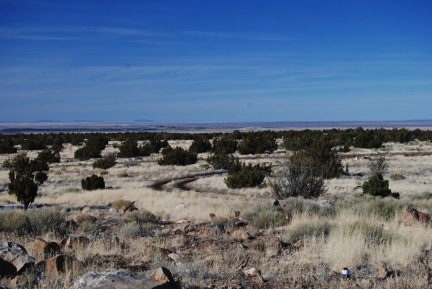 We sleep on a loft in the camping shed. There’s a wall to wall carpet up there with a mattress on top and a pair of very short night tables, one on each side. We make the bed just like we make our bed at home: with sheets and blankets and a cosy comforter. Our heads are right beneath a window that looks out on my favorite view: northwest toward Mount Trumbull.
We sleep on a loft in the camping shed. There’s a wall to wall carpet up there with a mattress on top and a pair of very short night tables, one on each side. We make the bed just like we make our bed at home: with sheets and blankets and a cosy comforter. Our heads are right beneath a window that looks out on my favorite view: northwest toward Mount Trumbull.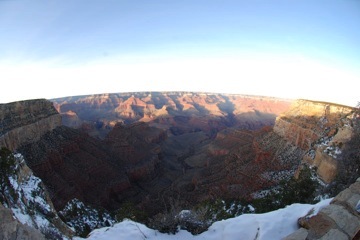 Inside the park, we got a parking spot in the small lot right near El Tovar, where we’d be eating dinner with friends. The hotel is right on the Rim, so we spent some time out on the pathway there, looking into the canyon as the sun was dipping ever lower into the southwestern sky. I played around with my fisheye lens — this was the first time I’d had a chance to use it at the Canyon — and got an interesting shot that includes the snow all around on the Rim.
Inside the park, we got a parking spot in the small lot right near El Tovar, where we’d be eating dinner with friends. The hotel is right on the Rim, so we spent some time out on the pathway there, looking into the canyon as the sun was dipping ever lower into the southwestern sky. I played around with my fisheye lens — this was the first time I’d had a chance to use it at the Canyon — and got an interesting shot that includes the snow all around on the Rim.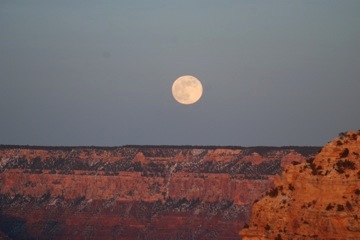 Afterwards, we came out for another peek into the canyon and were rewarded with a view of the newly risen full moon inching into the sky over the north rim. I snapped a few photos of it, but was too cold (or lazy?) to set up my tripod and do it properly, so the shots I took with my 200mm lens aren’t as clear as they could be.
Afterwards, we came out for another peek into the canyon and were rewarded with a view of the newly risen full moon inching into the sky over the north rim. I snapped a few photos of it, but was too cold (or lazy?) to set up my tripod and do it properly, so the shots I took with my 200mm lens aren’t as clear as they could be. After stopping for some photos inside the hotel lobby where a tall Christmas tree stretched up to the second floor, we stepped outside and walked back to the Rim. The moonlight was shining brightly down into the canyon, casting shadows that defined the rock walls. It was a beautiful scene, but one my camera couldn’t seem to capture properly. (I really need to play around a bit more with the bracketing feature.)
After stopping for some photos inside the hotel lobby where a tall Christmas tree stretched up to the second floor, we stepped outside and walked back to the Rim. The moonlight was shining brightly down into the canyon, casting shadows that defined the rock walls. It was a beautiful scene, but one my camera couldn’t seem to capture properly. (I really need to play around a bit more with the bracketing feature.)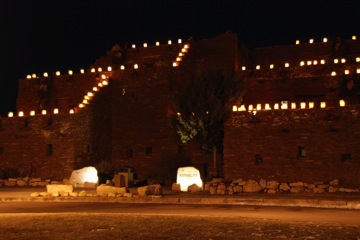 Since I was out there with my tripod, I took a few moments to photograph Hopi House and El Tovar. Hopi House was especially festive with its [electric] luminarias.
Since I was out there with my tripod, I took a few moments to photograph Hopi House and El Tovar. Hopi House was especially festive with its [electric] luminarias.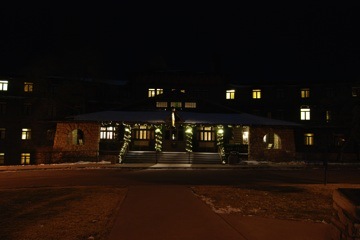 It was after 9:30 PM and it wasn’t very cold at all. The wind had died down and the air was crisp and dry. There wasn’t anyone around except us. That made good conditions for taking these photos. They create the illusion that the historic buildings along the Rim are private, special places. In reality, during the day, these places are mobbed with tourists and it would be nearly impossible to photograph them without including a few people in each shot.
It was after 9:30 PM and it wasn’t very cold at all. The wind had died down and the air was crisp and dry. There wasn’t anyone around except us. That made good conditions for taking these photos. They create the illusion that the historic buildings along the Rim are private, special places. In reality, during the day, these places are mobbed with tourists and it would be nearly impossible to photograph them without including a few people in each shot.